Navigate the enigmatic world of Cush in biblical maps, where ancient geography and divine narratives converge into a mystery awaiting unraveling.
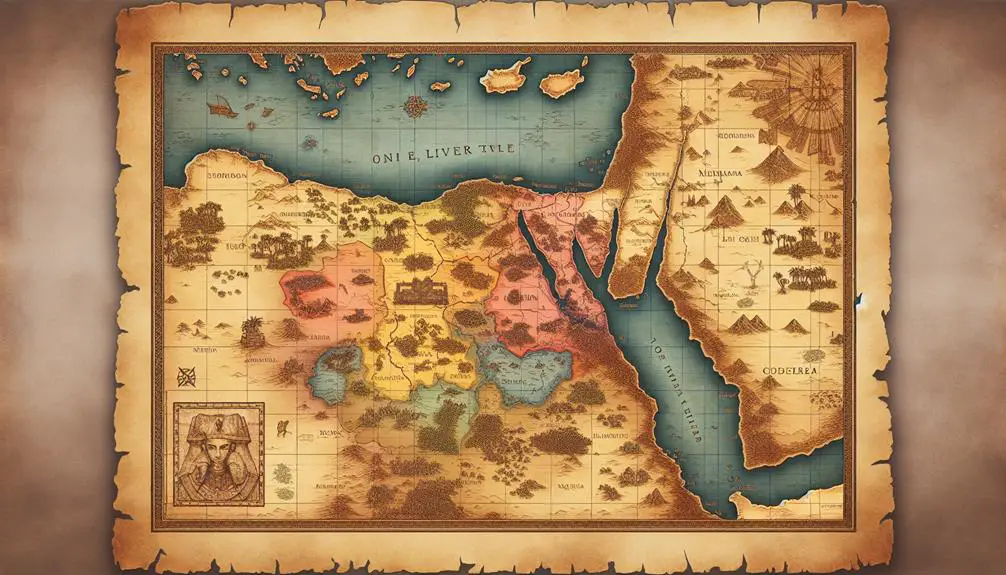
Cush in the Bible Map
You've surely stumbled upon the term 'Cush' in the Bible and thought to yourself, 'Ah, yes, another straightforward geographical reference that won't lead me down a rabbit hole of historical confusion.'
Yet, here you are, about to unwrap the layers of Cush's identity, which is as rich in mystery as it is in historical and biblical significance. Beyond being a mere name on ancient maps, Cush holds a pivotal place in understanding the interweaving of biblical narratives with historical geography.
Let's embark on this journey together to uncover the true essence of Cush, where every piece of evidence might lead to more questions than answers.
Key Takeaways
- Cush's biblical significance is underpinned by its deep historical roots and geopolitical influence.
- The geographic location of Cush, often equated with modern-day Sudan, plays a central role in biblical narratives and prophecies.
- Archaeological and cultural insights into Cush enrich our understanding of its role and representations in the Bible.
- Modern scholarship uses interdisciplinary approaches to more accurately define Cush's boundaries and its significance in biblical contexts.
Historical Background of Cush
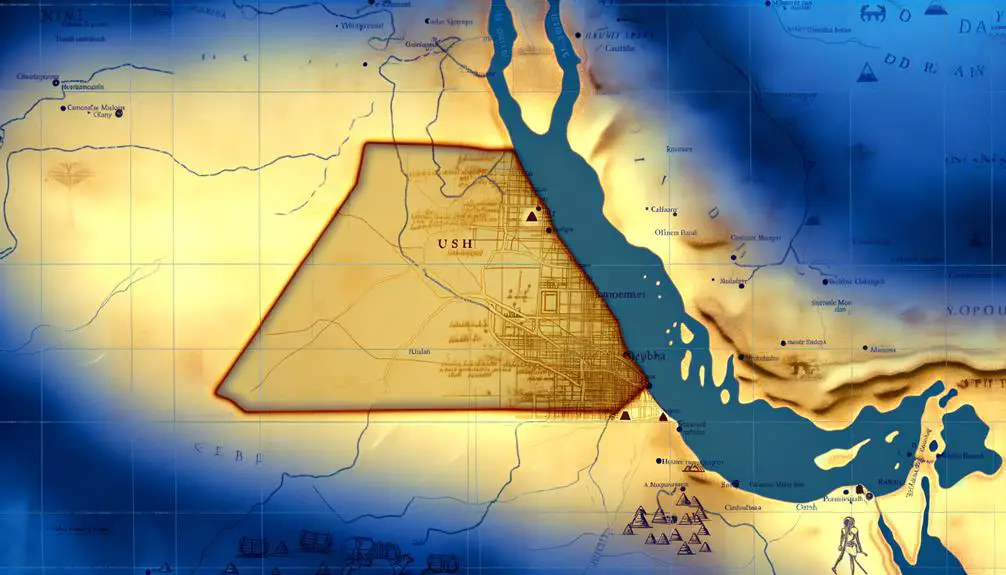
In the annals of ancient history, Cush occupies a significant position as a region intertwined with the narratives of early civilizations, notably within the context of the Bible. You'll find that the Cushite rulers played pivotal roles not just in political spheres but also in the intricate tapestry of trade networks that crisscrossed ancient Near East and Africa. These networks were vital arteries through which commerce, culture, and ideas flowed, knitting together disparate peoples and regions into a complex web of interdependence.
Analyzing the historical background of Cush requires a closer look at the accomplishments and influence of Cushite rulers. Their governance extended far beyond mere territorial control. These rulers were known for their sophisticated approach to international relations, leveraging their strategic position to facilitate trade between Africa, the Middle East, and beyond. This allowed them not only to amass wealth but also to act as cultural conduits, enabling the exchange of technologies, religious concepts, and artistic traditions.
The trade networks that Cush was part of were remarkably advanced for their time. They included routes traversing harsh deserts, winding rivers, and vast seas, connecting the ancient world in ways previously unimaginable. Goods such as gold, ivory, incense, and exotic animals flowed through these networks, marking Cush as a vital player in ancient economy and politics.
This deep dive into the historical context of Cush and its rulers underscores the region's significance in shaping the ancient world. By understanding the sophisticated systems of governance and trade that Cushite rulers established, you gain insights into the far-reaching impact of this ancient civilization on global history.
Cush's Biblical References
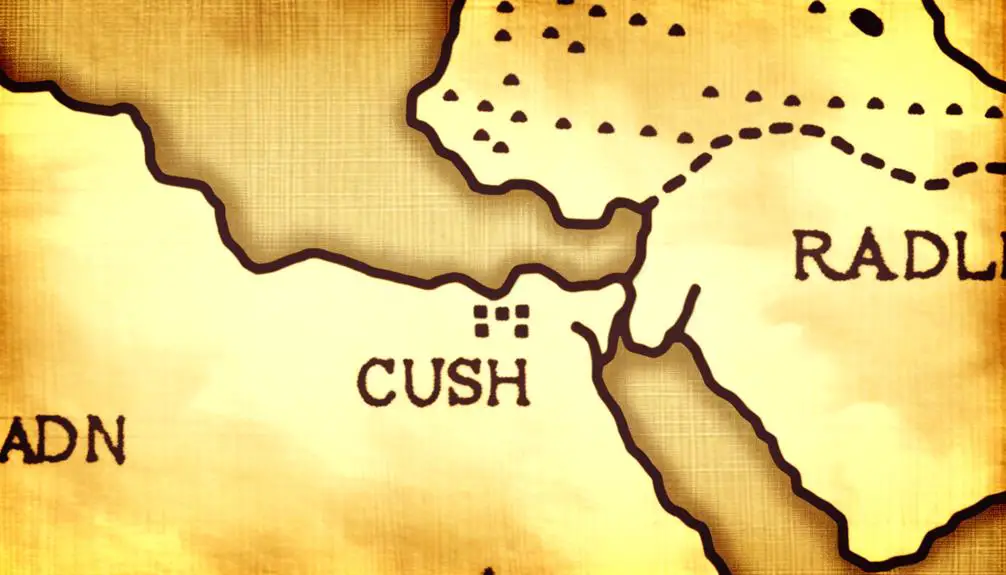
You'll find that Cush's presence in the Bible isn't merely geographical but deeply interwoven with narratives of lineage and prophecy.
The region's depiction, from its specific location to the descendants that populated it, provides critical insights into biblical ethnography and historical movements.
Moreover, Cush's mention in prophecies underscores its significance within the biblical world, offering a lens through which to examine the interplay between geography and divine foretelling.
Cush's Geographic Location
Throughout biblical texts, Cush frequently emerges as a significant geographical entity, often identified with the region south of Egypt, encompassing modern-day Sudan. This area's climate, predominantly hot and arid, significantly influenced its historical trade routes. These routes became conduits for cultural and commercial exchanges between Africa and the broader ancient world.
Feature |
Description |
Relevance |
|---|---|---|
Climate |
Hot and arid |
Shaped living conditions and agriculture |
Geography |
South of Egypt |
Strategic location for trade |
Trade Routes |
Connected to Egypt and beyond |
Facilitated cultural and commercial exchanges |
Modern-Day Equivalent |
Sudan |
Offers insights into historical Cush |
Biblical Importance |
Frequently mentioned |
Highlights its significance in ancient narratives |
This detailed analysis reveals how Cush's geographical and climatic conditions directly impacted its historical significance and its depiction in biblical narratives.
Descendants of Cush
Having explored the geographical significance of Cush, let's now examine its notable descendants as referenced within biblical texts, shedding light on their roles and impacts in ancient narratives.
Cush's legacy, deeply intertwined with the tapestry of biblical history, offers a rich field for scholarly analysis and interpretation. The descendants of Cush, often identified within the context of various tribes and nations, are pivotal in understanding the spread and influence of Cushite culture and genetic heritage.
Genetic studies have begun to unravel the complex lineage and migrations of these groups, providing a fascinating glimpse into the ancient world. Such research not only enriches our understanding of Cush's progeny but also illuminates the broader dynamics of human history and movement in the biblical era.
Cush in Prophecies
Cush's role in biblical prophecies, often depicted through vivid imagery and symbolic language, offers a profound insight into the region's spiritual and historical significance within the sacred texts. Analyzing Cush's symbolism and prophetic interpretations provides a unique lens through which to view its pivotal involvement in biblical narratives.
Reference |
Symbolism |
Prophetic Interpretation |
|---|---|---|
Isaiah 18 |
A land beyond rivers |
A call for attention from distant lands |
Ezekiel 30 |
Cush with Egypt |
Impending judgment on allies |
Psalm 68 |
Cush hastening gifts |
Submission and homage to God |
Zephaniah 3 |
Scattered peoples |
A promise of restoration and gathering |
These references highlight Cush's multifaceted role, ranging from a symbol of distant nations to a participant in divine judgments and redemptions, showcasing the complex interplay between geography and prophecy in biblical texts.
Geographical Location Theories
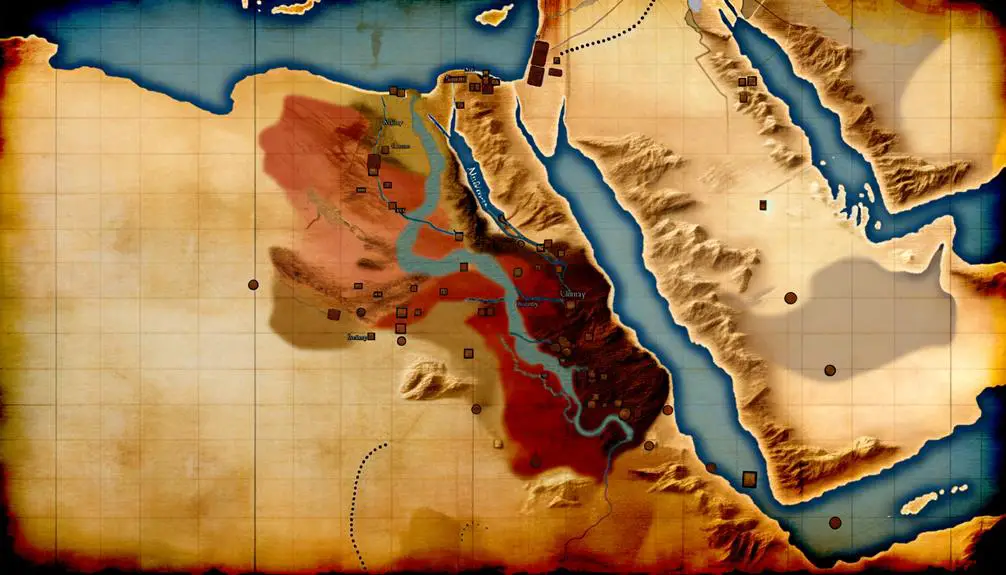
Several theories exist regarding the precise geographical location of Cush, each supported by different interpretations of historical and biblical texts. You'll find that scholars have long debated over where Cush was, driven by different pieces of evidence that point to various regions. Understanding these theories requires a deep dive into historical contexts, Cushite migrations, and how climate influences may have shaped the movements of peoples and the identification of geographical locations over time.
- The Upper Nile Theory: Many scholars align Cush with regions along the Upper Nile, including parts of modern-day Sudan. This theory is supported by references to Cush in biblical texts that describe it as a land south of Egypt, rich in gold and other resources. Historical records of Cushite migrations suggest a movement of peoples within this area, influenced by changing climate conditions and the pursuit of fertile lands.
- The Arabian Peninsula Theory: Some argue that Cush also extended into parts of the Arabian Peninsula, considering trade routes and archaeological findings that suggest a Cushite presence. This perspective emphasizes the adaptability and mobility of Cushite peoples influenced by trade opportunities and climate variations.
- The African Interior Theory: Another viewpoint suggests that Cush stretched further into the African interior, beyond the Nile valley. This theory considers the broader impacts of climate influences on migration patterns, proposing that Cushite groups might've explored and settled in diverse African terrains in search of resources and suitable living conditions.
- The Multiple Locations Theory: Lastly, there's a theory proposing that 'Cush' referred to multiple, non-contiguous areas at different times, reflecting the dynamic nature of ancient geopolitics, migrations, and the fluid identities of peoples and places.
Analyzing these theories reveals the complexity in pinpointing Cush's exact location, highlighting the interplay between environmental factors and human movements in ancient history.
Archaeological Discoveries Related to Cush
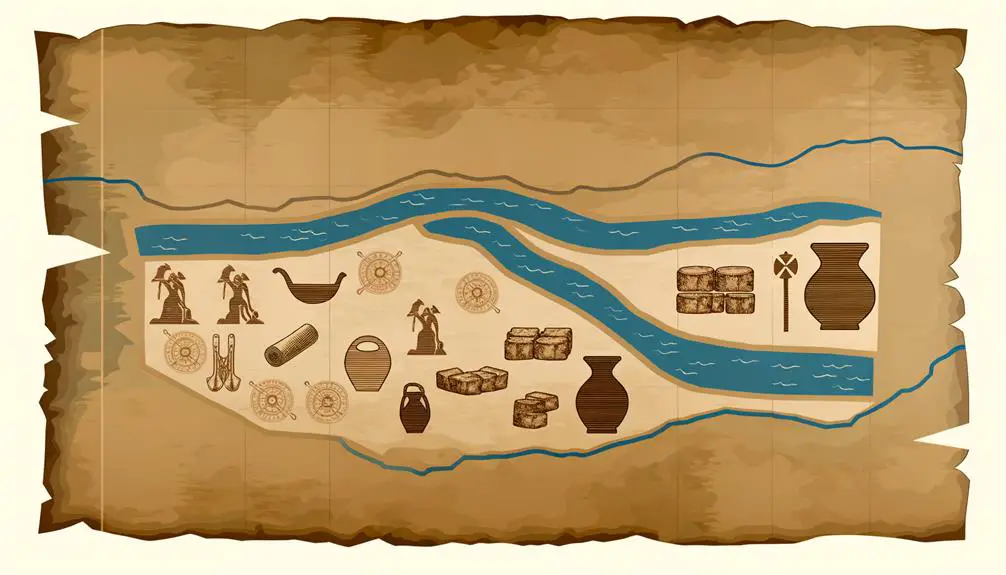
Archaeological endeavors have unearthed compelling evidence, shedding light on the once elusive realm of Cush and its historical footprint across various landscapes. Through meticulous excavations and analysis, scholars have pieced together aspects of Cushite trade, providing a clearer picture of their economic activities and interactions with neighboring regions. Artistic representations discovered in tombs and ruins, on the other hand, offer a window into the cultural and societal norms of the Cushite people.
The remnants of trading posts and goods found along ancient routes underscore the pivotal role of Cush in facilitating commerce between Africa, the Middle East, and possibly beyond. These findings suggest a network of trade that was sophisticated and far-reaching, challenging previous assumptions about the isolation of ancient African civilizations. The presence of luxury items such as gold, ivory, and exotic animal skins in archaeological sites points to the wealth and prosperity derived from these trade endeavors.
Artistic representations unearthed in Cush and surrounding areas depict a society rich in culture and diversity. Frescoes, sculptures, and pottery reveal a unique aesthetic that blends indigenous and foreign influences, reflecting the cosmopolitan nature of Cushite society. These artworks not only serve as evidence of the artistic prowess of the Cushites but also provide insights into their religious beliefs, social hierarchy, and daily life.
Cush in Ancient Texts and Traditions
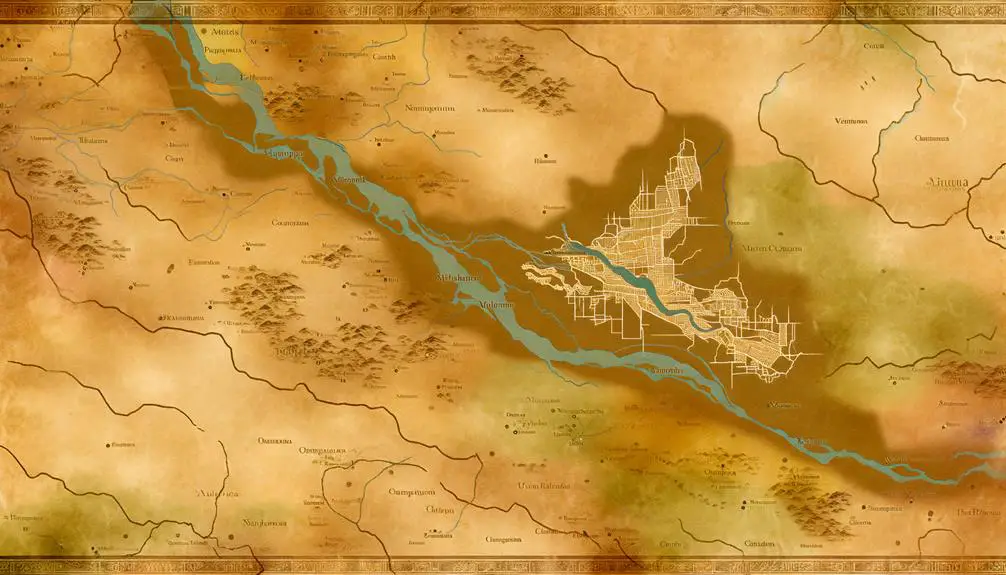
Ancient texts and traditions weave a complex tapestry that depicts Cush as a vibrant, interconnected realm deeply embedded in the historical narratives of neighboring civilizations. You'll find that Cushite mythology and the extensive trade networks Cush engaged in aren't merely footnotes in historical documents but critical components that shaped the region's identity and its interactions with surrounding powers.
To understand the significance of Cush in ancient texts and traditions, consider the following points:
- Cushite Mythology: Cushite deities and myths are mentioned in various ancient texts, reflecting a rich spiritual life that influenced and was influenced by neighboring cultures. The interplay between Cushite mythology and that of Egypt, in particular, demonstrates a deep cultural exchange and shared religious concepts.
- Trade Networks: Cush's strategic location along the Nile and its proximity to the Red Sea facilitated extensive trade networks that connected it to Africa, the Middle East, and beyond. These networks are detailed in historical records, highlighting Cush's role as a trade hub that disseminated goods, ideas, and cultural practices.
- Historical Relations: Diplomatic and sometimes conflictual relationships between Cush and its neighbors, such as Egypt, are well-documented. These interactions are crucial for understanding the geopolitical landscape of the region and Cush's place within it.
- Cultural Exchanges: The exchange of art, language, and religious practices with neighboring civilizations, especially Egypt, is evident in the archaeological and textual record. This exchange underscores the interconnected nature of ancient civilizations and Cush's significant role in the cultural evolution of the region.
Through these lenses, you gain a deeper appreciation for Cush's historical significance and its enduring legacy in the tapestry of human history.
The People of Cush: An Overview
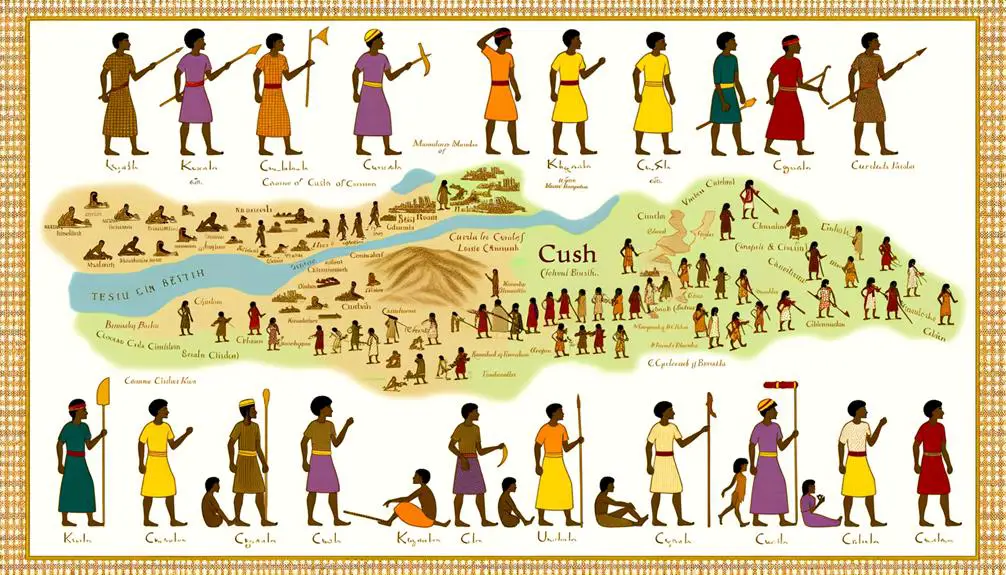
Having explored the rich tapestry of Cushite mythology and its vibrant trade networks, we now turn our focus to the heart of Cush's historical narrative: its people. The Cushites, living in regions that today encompass parts of modern Sudan and Ethiopia, were not a monolithic entity but rather a mosaic of ethnicities and cultures united under the umbrella of Cushite languages and shared traditions. Their societal structures were as complex as the trade routes that crisscrossed their territories, connecting them to distant lands and cultures, from the Mediterranean to the Arabian Peninsula.
Aspect |
Detail |
Impact on Society |
|---|---|---|
Languages |
Diverse Cushite languages; a mix of Nilo-Saharan and Afro-Asiatic roots. |
Facilitated trade and cultural exchange. |
Trade Routes |
Extended from the Nile Valley to the Red Sea, and beyond. |
Enabled the influx of goods, ideas, and technological innovations. |
Social Structure |
Hierarchical, with a ruling elite overseeing various aspects of daily life and trade. |
Ensured the efficient management of resources and defense. |
This intricate network of trade routes not only allowed for the exchange of commodities such as gold, ivory, and incense but also fostered a rich cultural exchange that influenced Cushite society's development. The adoption of ironworking techniques and the spread of agricultural innovations are testament to this interchange. Moreover, the Cushite languages, with their diverse roots, served as a linguistic bridge that facilitated these exchanges, underscoring the importance of communication in the ancient world. The Cushites' story, therefore, is not merely one of isolation but of dynamic interaction with their neighbors, driven by the forces of trade and the exchange of ideas.
Modern Scholarship and Interpretations
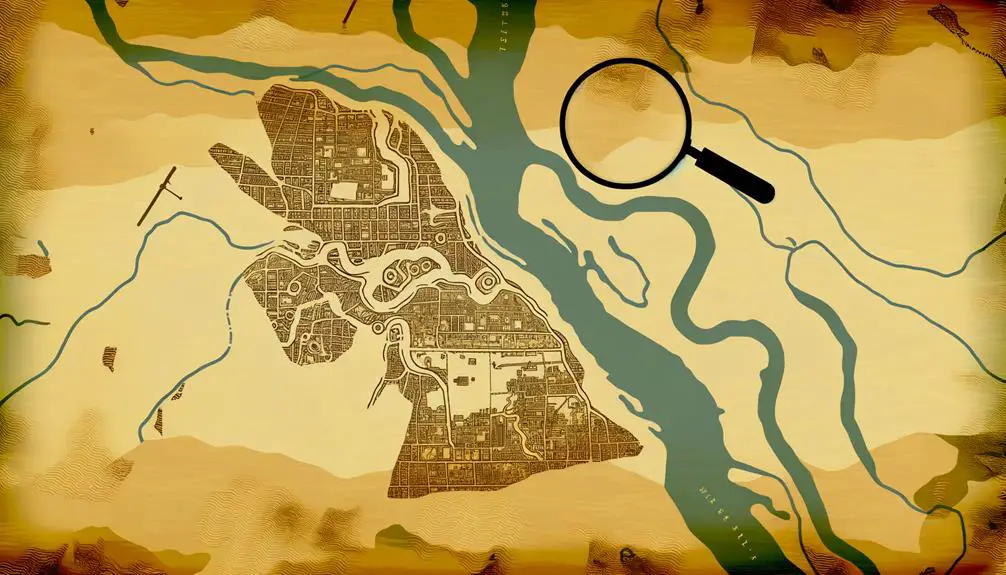
You'll find that modern scholarship grapples with significant challenges in pinpointing the exact geographic boundaries of Cush as mentioned in biblical texts. Scholars meticulously analyze ancient manuscripts, comparing linguistic nuances and historical contexts to shed light on this elusive region.
Furthermore, theories surrounding the ethnicity of the Cushite people are complex, drawing on a diverse range of archaeological, genetic, and literary evidence to propose nuanced interpretations.
Geographic Identification Challenges
Identifying Cush's precise geographic boundaries presents a considerable challenge for modern scholars, due to a combination of sparse contemporary records and evolving interpretations. With the advancement of mapping tools, researchers can now better visualize ancient landscapes, yet the task remains daunting. Climate impact over centuries has dramatically altered terrains, further complicating the identification process.
- Sparse Records: Limited historical documentation makes it difficult to pinpoint Cush's exact locations.
- Evolving Interpretations: Scholars' understanding and interpretations of ancient texts and maps continually change.
- Advancement of Mapping Tools: Modern technologies offer new ways to visualize ancient geographies but aren't always definitive.
- Climate Impact: Environmental changes over time have reshaped the landscape, obscuring ancient geographic markers.
Ancient Texts Analysis
Modern scholars meticulously analyze ancient texts to unravel the geographical enigma of Cush, employing a blend of linguistic expertise and historical context to refine our understanding of its boundaries. Through the lens of textual criticism, they scrutinize manuscript variations, delving deep into the subtleties of language that have evolved over centuries.
This rigorous examination sheds light on how different interpretations of the same passages might reflect alternate views of Cush's extent and location. By comparing texts across various sources, scholars uncover the layers of historical sedimentation that have obscured the original meaning.
Their work is foundational, as it not only deciphers the ancient script but also reconstructs the worldview of those who wrote about Cush, providing invaluable insights into the ancient Near East's complex tapestry of cultures and territories.
Theories of Ethnicity
In exploring the theories of ethnicity within the context of Cush, scholars rigorously dissect the interplay between ancient narratives and modern interpretations to elucidate the ethnic dimensions of this historical region.
- Genetic Markers:
Genetic studies reveal a complex ancestry, reflecting migrations and interactions over millennia. These markers are pivotal in reconstructing the ethnic landscapes of ancient Cush.
- Linguistic Evidence:
The analysis of ancient languages and scripts associated with Cush provides insights into ethnic affiliations and cultural exchanges.
- Cultural Practices:
Unique traditions and rituals distinguish Cushitic peoples, offering a lens into their societal structures and beliefs.
- Archaeological Data:
Material culture, from pottery to architecture, serves as tangible evidence of the ethnic diversity and evolution within Cush, bridging gaps left by historical narratives.
Frequently Asked Questions
How Has the Interpretation of Cush's Location Influenced Modern Geopolitical Boundaries in Africa and the Middle East?
Interpreting Cush's location has significantly impacted modern geopolitical boundaries in Africa and the Middle East by influencing trade routes and diplomatic relations.
You'll see that historical interpretations have shaped economic and political interactions, leading to alliances or disputes over territories.
This understanding has carved out spheres of influence, redirecting trade pathways and fostering or straining diplomatic engagements.
It's crucial to grasp how these historical perceptions continue to mold contemporary geopolitical landscapes, affecting regional stability and cooperation.
Are There Any Contemporary Cultural or Religious Practices That Can Be Directly Traced Back to the Ancient Cushite Civilization?
You might think finding a needle in a haystack is hard, but tracing contemporary practices back to ancient Cushite civilization is equally challenging. Yet, it's not impossible.
Modern Cushites still reflect aspects of their rich heritage. Through Cushite artifacts and meticulous historical analysis, scholars have unearthed rituals and cultural practices that shine a light on the past. These findings provide a fascinating glimpse into how ancient traditions have shaped today's cultural landscapes.
How Do Various Bible Translations Differ in Their Depiction of Cush, and What Impact Do These Differences Have on Theological Understanding?
Different Bible translations vary in how they depict Cush, affecting your understanding of its theological implications. You'll find that translation accuracy is crucial; some versions might generalize Cush as Ethiopia, while others specify regions or tribes.
This variance influences how you interpret biblical narratives and prophecies related to Cush. Analyzing these differences helps you grasp the nuanced theological meanings, ensuring a deeper, more accurate comprehension of biblical texts concerning Cush.
Has the Study of Cush in the Bible Contributed to Any Significant Changes in Historical or Biblical Education Curricula in Recent Years?
Yes, the study of Cush in the Bible has indeed led to notable changes in historical and biblical education curricula recently. By integrating archaeological methodologies and cutting-edge educational technologies, scholars have deepened our understanding of Cush's role and its depiction in biblical texts.
This refined insight has prompted educators to revise lesson plans and teaching materials, ensuring students receive a more accurate and comprehensive historical and theological education.
What Are the Environmental and Climatic Factors That Might Have Influenced the Development and Decline of the Cushite Civilization, According to Recent Scientific Studies?
Recent scientific studies suggest that environmental and climatic factors played a crucial role in the development and decline of the Cushite civilization.
You'll find that agricultural innovations were significantly influenced by the region's fluctuating climate, affecting food production and stability.
Additionally, changing climatic conditions impacted the viability of ancient trade routes, crucial for economic prosperity.
These environmental shifts prompted adaptations but also contributed to the civilization's eventual decline.
Conclusion
As you've journeyed through the enigmatic lands of Cush, dissected its biblical allusions, and delved into its geographical mysteries, a fascinating tapestry of history and lore has unfolded.
Yet, the true essence of Cush remains shrouded in the sands of time, teasing scholars and enthusiasts alike. Every archaeological dig and ancient text discovered brings us closer, yet the full story of the Cushite people tantalizingly hovers just beyond reach.
What secrets does Cush still hold? The quest for understanding continues.



Sign up